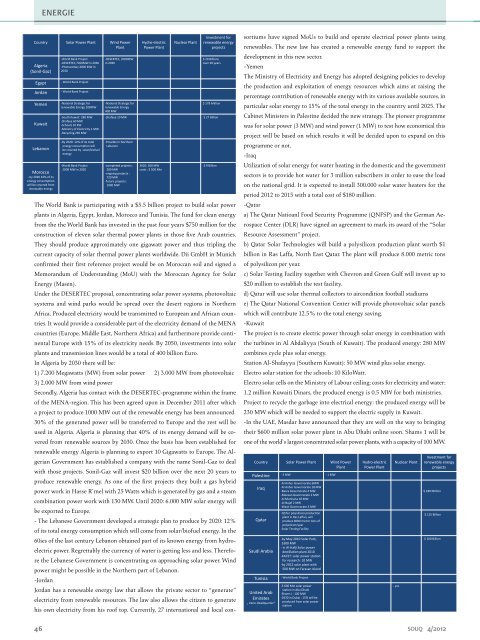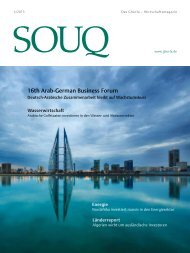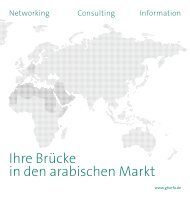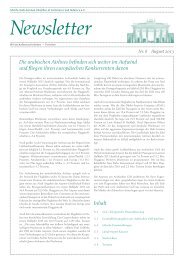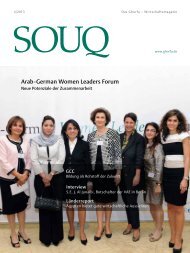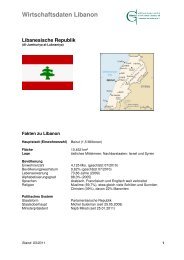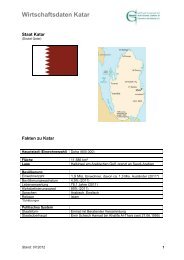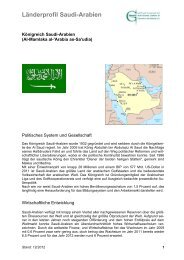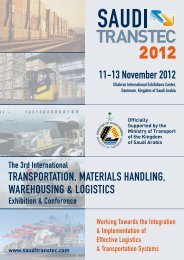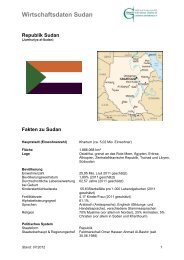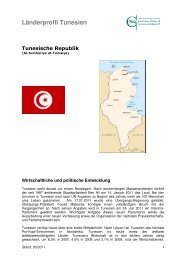Ausgabe 4/2012 - Ghorfa
Ausgabe 4/2012 - Ghorfa
Ausgabe 4/2012 - Ghorfa
Erfolgreiche ePaper selbst erstellen
Machen Sie aus Ihren PDF Publikationen ein blätterbares Flipbook mit unserer einzigartigen Google optimierten e-Paper Software.
ENErGIE<br />
Country<br />
Algeria<br />
(Sonil-Gaz)<br />
Egypt<br />
Jordan<br />
Yemen<br />
Kuwait<br />
Lebanon<br />
Morocco<br />
- by 2020 42% of its<br />
energy consumption<br />
will be covered from<br />
renewable energy<br />
Solar Power Plant<br />
-World Bank Project<br />
-DESERTEC,7200MW in 2030<br />
-Photovoltaic,3000 MW in<br />
2030<br />
- World Bank Project<br />
- World Bank Project<br />
-National Strategic for<br />
renewable Energy 108MW<br />
-South Kuwait 280 MW<br />
-Shafaya 60 MW<br />
-Schools 10 KW<br />
-Ministry of Electricity 1 MW<br />
-Recycling 230 MW<br />
-By 2020: 12% of its total<br />
energy consumption will<br />
be covered by solar/biofuel<br />
energy<br />
-World Bank Project<br />
2000 MW in 2020<br />
Wind Power<br />
Plant<br />
-DESERTEC, 2000MW<br />
in 2030<br />
-National Strategic for<br />
renewable Energy<br />
400 MW<br />
-Shafaya 10 MW<br />
-Possible in Northern<br />
Lebanon<br />
-completed projects:<br />
280 MW<br />
-ongoing projects :<br />
720 MW<br />
-future projects :<br />
1000 MW<br />
Hydro-electric<br />
Power Plant<br />
2020: 300 MW<br />
costs : $ 500 Mio<br />
Nuclear Plant<br />
Investment for<br />
renewable energy<br />
projects<br />
$ 20 Billions<br />
over 20 years<br />
$ 178 Million<br />
$ 27 Billion<br />
$ 9 Billion<br />
The World Bank is participating with a $5.5 billion project to build solar power<br />
plants in Algeria, Egypt, Jordan, Morocco and Tunisia. The fund for clean energy<br />
from the the World Bank has invested in the past four years $750 million for the<br />
construction of eleven solar thermal power plants in those five Arab countries.<br />
They should produce approximately one gigawatt power and thus tripling the<br />
current capacity of solar thermal power plants worldwide. Dii GmbH in Munich<br />
confirmed their first reference project would be on Moroccan soil and signed a<br />
Memorandum of Understanding (MoU) with the Moroccan Agency for Solar<br />
Energy (Masen).<br />
Under the DESERTEC proposal, concentrating solar power systems, photovoltaic<br />
systems and wind parks would be spread over the desert regions in Northern<br />
Africa. Produced electricity would be transmitted to European and African countries.<br />
It would provide a considerable part of the electricity demand of the MENA<br />
countries (Europe, Middle East, Northern Africa) and furthermore provide continental<br />
Europe with 15% of its electricity needs. By 2050, investments into solar<br />
plants and transmission lines would be a total of 400 billion Euro.<br />
In Algeria by 2030 there will be:<br />
1) 7.200 Megawatts (MW) from solar power 2) 3.000 MW from photovoltaic<br />
3) 2.000 MW from wind power<br />
Secondly, Algeria has contact with the DESERTEC-programme within the frame<br />
of the MENA-region. This has been agreed upon in December 2011 after which<br />
a project to produce 1000 MW out of the renewable energy has been announced.<br />
30% of the generated power will be transferred to Europe and the rest will be<br />
used in Algeria. Algeria is planning that 40% of its energy demand will be covered<br />
from renewable sources by 2030. Once the basis has been established for<br />
renewable energy Algeria is planning to export 10 Gigawatts to Europe. The Algerian<br />
Government has established a company with the name Sonil-Gaz to deal<br />
with those projects. Sonil-Gaz will invest $20 billion over the next 20 years to<br />
produce renewable energy. As one of the first projects they built a gas hybrid<br />
power work in Hasse R`mel with 25 Watts which is generated by gas and a steam<br />
combination power work with 130 MW. Until 2020: 6.000 MW solar energy will<br />
be exported to Europe.<br />
- The Lebanese Government developed a strategic plan to produce by 2020: 12%<br />
of its total energy consumption which will come from solar/biofuel energy. In the<br />
60ies of the last century Lebanon obtained part of its known energy from hydroelectric<br />
power. Regrettably the currency of water is getting less and less. Therefore<br />
the Lebanese Government is concentrating on approaching solar power. Wind<br />
power might be possible in the Northern part of Lebanon.<br />
-Jordan<br />
Jordan has a renewable energy law that allows the private sector to “generate”<br />
electricity from renewable resources. The law also allows the citizen to generate<br />
his own electricity from his roof top. Currently, 27 international and local con-<br />
sortiums have signed MoUs to build and operate electrical power plants using<br />
renewables. The new law has created a renewable energy fund to support the<br />
development in this new sector.<br />
-Yemen<br />
The Ministry of Electricity and Energy has adopted designing policies to develop<br />
the production and exploitation of energy resources which aims at raising the<br />
percentage contribution of renewable energy with its various available sources, in<br />
particular solar energy to 15% of the total energy in the country until 2025. The<br />
Cabinet Ministers in Palestine decided the new strategy. The pioneer programme<br />
was for solar power (3 MW) and wind power (1 MW) to test how economical this<br />
project will be based on which results it will be decided upon to expand on this<br />
programme or not.<br />
-Iraq<br />
Utilization of solar energy for water heating in the domestic and the government<br />
sectors is to provide hot water for 3 million subscribers in order to ease the load<br />
on the national grid. It is expected to install 300.000 solar water heaters for the<br />
period <strong>2012</strong> to 2015 with a total cost of $180 million.<br />
-Qatar<br />
a) The Qatar Natioanl Food Security Programme (QNFSP) and the German Aerospace<br />
Center (DLR) have signed an agreement to mark its award of the “Solar<br />
Resource Assessment” project.<br />
b) Qatar Solar Technologies will build a polysilicon production plant worth $1<br />
billion in Ras Laffa, North East Qatar. The plant will produce 8.000 metric tons<br />
of polysilicon per year.<br />
c) Solar Testing Facility together with Chevron and Green Gulf will invest up to<br />
$20 million to establish the test facility.<br />
d) Qatar will use solar thermal collectors to aircondition football stadiums<br />
e) The Qatar National Convention Center will provide photovoltaic solar panels<br />
which will contribute 12.5% to the total energy saving.<br />
-Kuwait<br />
The project is to create electric power through solar energy in combination with<br />
the turbines in Al Abdaliyya (South of Kuwait). The produced energy: 280 MW<br />
combines cycle plus solar energy.<br />
Station Al-Shafayya (Southern Kuwait): 50 MW wind plus solar energy.<br />
Electro solar station for the schools: 10 KiloWatt.<br />
Electro solar cells on the Ministry of Labour ceiling: costs for electricity and water:<br />
1.2 million Kuwaiti Dinars, the produced energy is 0.5 MW for both ministries.<br />
Project to recycle the garbage into electrical energy: the produced energy will be<br />
230 MW which will be needed to support the electric supply in Kuwait.<br />
-In the UAE, Masdar have announced that they are well on the way to bringing<br />
their $600 million solar power plant in Abu Dhabi online soon. Shams 1 will be<br />
one of the world`s largest concentrated solar power plants, with a capacity of 100 MW.<br />
Solar Power Plant<br />
Hydro-electric<br />
Power Plant<br />
Nuclear Plant<br />
Investment for<br />
renewable energy<br />
projects<br />
46 SOUQ 4/<strong>2012</strong><br />
Country<br />
Palestine<br />
Iraq<br />
Qatar<br />
Saudi Arabia<br />
Tunisia<br />
United Arab<br />
Emirates<br />
„ Irene-Headquarter“<br />
- 3 MW<br />
-Al Anhur Governorate 6MW<br />
-Al Anbar Governorate 18 MW<br />
-Basra Governorate 4 MW<br />
-Meesan Governorate 2 MW<br />
-Al Munhana 18 MW<br />
-Al Najaf 2 MW<br />
-Wasit Governorate 3 MW<br />
-QSTec polysilicon production<br />
plant in Ras Laffan, will<br />
produce 8000 metric tons of<br />
polysilicon/year<br />
-Solar Testing Facility<br />
-by May 2010 Solar Park,<br />
3300 MW<br />
- in Al-Hafji Solar power<br />
destillation plant 2010<br />
-KACST: solar power station<br />
for research: 10 MW<br />
-by <strong>2012</strong> solar plant with<br />
500 MW on Farasan Island<br />
- World Bank Project<br />
-$ 600 Mio solar power<br />
station in Abu Dhabi<br />
-Shams I : 100 MW<br />
-2030 in Dubai : 15% will be<br />
produced from solar power<br />
station<br />
Wind Power<br />
Plant<br />
- 1 MW<br />
- yes<br />
$ 180 Million<br />
$ 125 Billion<br />
$ 100 Billion


